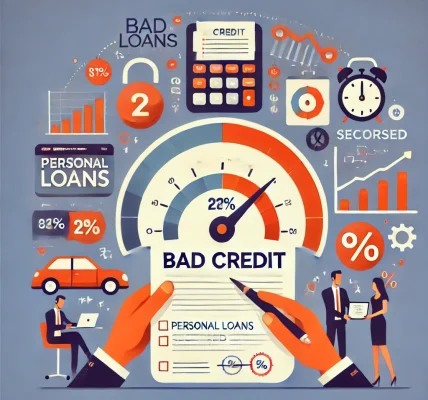Introduction
Not all debt is created equal. While borrowing money is often seen as a financial burden, certain types of debt can help build wealth and improve your financial future. Understanding the difference between good debt and bad debt is crucial to making smart borrowing decisions. In this guide, we’ll break down what makes debt beneficial or harmful, how to borrow wisely, and strategies to manage debt responsibly.
What is Good Debt?
Good debt refers to borrowing that contributes to long-term financial growth or enhances your overall net worth. It usually comes with low interest rates and the potential for future returns.
Examples of Good Debt:
1. Mortgage Loans
- Buying a home is considered a good investment because real estate tends to appreciate over time.
- Mortgage loans typically have lower interest rates compared to other forms of debt.
- Homeownership builds equity, which can later be used for further financial growth.
2. Student Loans
- Education can increase earning potential, making student loans an investment in your future.
- Federal student loans often have lower interest rates and flexible repayment plans.
3. Business Loans
- Borrowing to start or expand a business can lead to increased income and financial stability.
- Loans used for business growth can provide tax benefits and long-term profits.
4. Auto Loans (When Used Wisely)
- Buying a vehicle needed for work or business purposes can be considered good debt.
- Choosing a car within budget and with low-interest financing ensures manageable payments.
5. Investments in Real Estate
- Rental properties or investment real estate can generate passive income and appreciate in value.
- Proper research and planning are essential to ensure positive returns.
What is Bad Debt?
Bad debt typically refers to borrowing for purchases that don’t appreciate in value or generate future financial benefits. These debts usually have high-interest rates and contribute to financial strain.
Examples of Bad Debt:
1. High-Interest Credit Card Debt
- Credit card balances often carry high-interest rates, making them expensive to maintain.
- Carrying a balance instead of paying in full leads to increasing debt due to interest accumulation.
2. Payday Loans
- These short-term loans come with extremely high interest rates and fees.
- They often lead to a cycle of borrowing that becomes difficult to break.
3. Personal Loans for Non-Essential Expenses
- Borrowing for luxury vacations, expensive gadgets, or designer items adds financial strain without long-term benefits.
- High-interest personal loans can quickly become unmanageable.
4. Auto Loans (When Misused)
- Financing an expensive car that depreciates quickly can lead to financial losses.
- Long-term car loans with high interest rates increase the total cost of the vehicle.
5. Retail Store Financing
- Store credit cards often have higher interest rates than regular credit cards.
- Deferred interest promotions can result in large payments if the balance isn’t paid off in time.
How to Borrow Smartly
To ensure that borrowing works in your favor, follow these key strategies:
1. Assess Your Needs vs. Wants
- Before taking on debt, ask yourself if the purchase is necessary or a luxury.
- Prioritize essential expenses that contribute to long-term financial stability.
2. Compare Interest Rates and Loan Terms
- Shop around for the best interest rates and repayment terms before borrowing.
- Look for low APR (Annual Percentage Rate) options to minimize interest costs.
3. Borrow Only What You Can Afford
- Ensure that monthly loan payments fit within your budget.
- Avoid borrowing the maximum amount offered by lenders if unnecessary.
4. Pay Off High-Interest Debt First
- Focus on repaying high-interest debts (like credit cards) to avoid excessive interest charges.
- Use the debt avalanche method (paying off high-interest debt first) or debt snowball method (paying off small debts first for motivation).
5. Maintain a Good Credit Score
- A high credit score can help you qualify for lower interest rates.
- Make on-time payments and keep credit utilization low to maintain a strong credit profile.
6. Use Debt for Investments, Not Liabilities
- Take on debt only when it contributes to financial growth (e.g., education, property, business expansion).
- Avoid loans that fund lifestyle expenses with no return on investment.
7. Understand Loan Terms and Hidden Fees
- Read the fine print on loans and credit agreements to avoid unexpected charges.
- Watch out for prepayment penalties, hidden fees, and variable interest rates.
Managing Debt Effectively
Even good debt requires proper management to avoid financial stress. Follow these best practices:
✅ Create a Repayment Plan: Set up a budget that includes debt repayment as a priority. ✅ Build an Emergency Fund: Having savings can prevent you from relying on high-interest debt in emergencies. ✅ Consider Refinancing: If you have high-interest loans, refinancing for a lower rate can save money. ✅ Avoid Late Payments: Set up automatic payments or reminders to prevent late fees and credit score damage.
Conclusion
Debt is a tool that, when used wisely, can improve your financial future. By understanding the difference between good and bad debt, making smart borrowing decisions, and managing debt responsibly, you can stay financially secure and avoid unnecessary stress.




